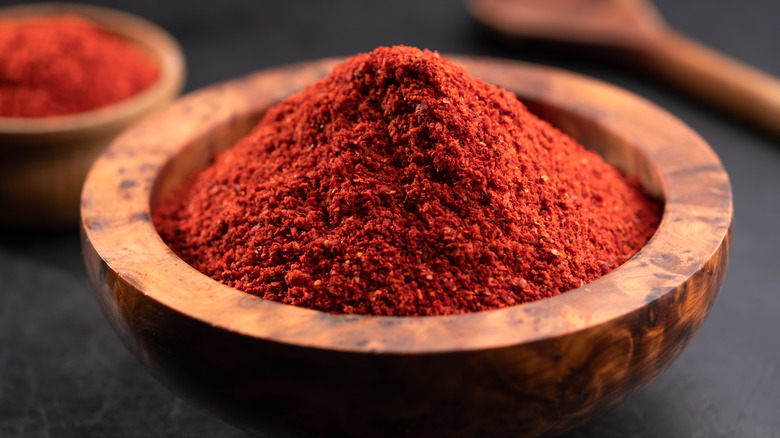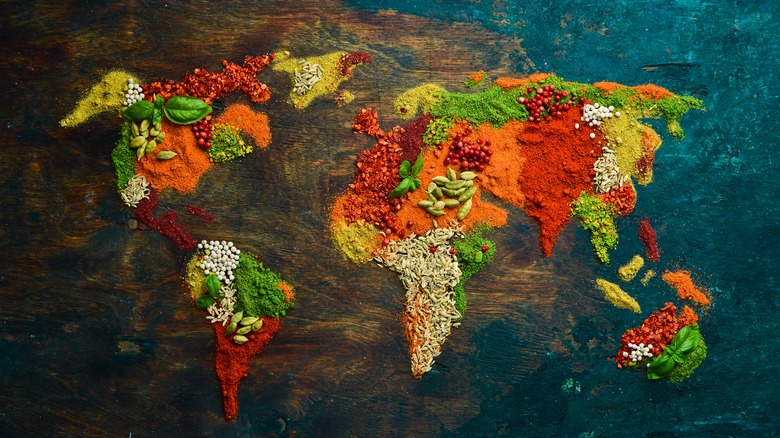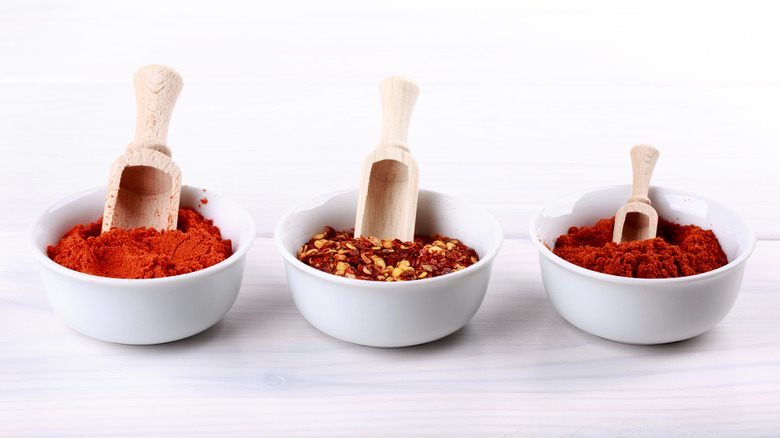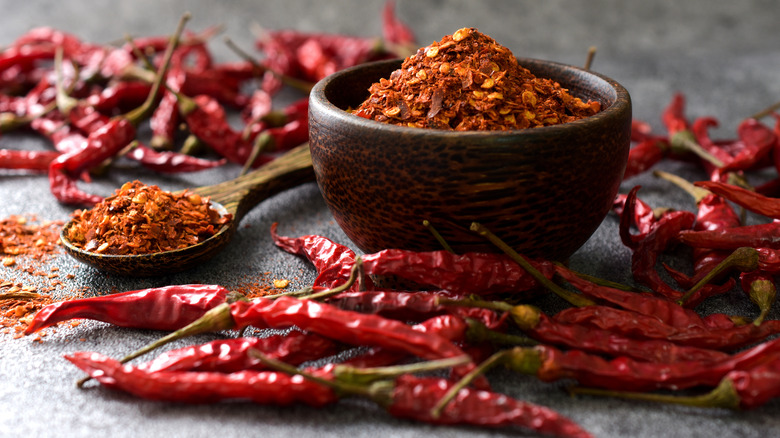Everything You Need To Know About Paprika
A bright dash of color, just a hint of spice, and countless dishes on its endless resume, paprika is truly an every-spice found in every supermarket, every red-shaded dish worth its spice, and every respectable chef home's spice cabinet. You have most probably experienced its flavorful heat, and if not you've most definitely experienced its visual warmth — such is the long red reach of paprika.
Paprika is a spice made from finely dried and ground up red peppers, often of several different varieties, flavor profiles, and shades of color. Paprika keeps it spicy and simple. Its versatility and wide availability mean that it's a staple not only for Western foods, but for cuisines the world over. From Korea to Hungary to Mexico, paprika finds its culinary niche and knows how to play its part. So let's get to know a little about this staple spice in the old utility belt.
The colorful history of paprika
All chili peppers, including those used to make paprika, originated in the Americas, specifically the central regions of Mexico and other regions in Central America, per MySpicer.com. Here, these peppers were grown and cultivated by the native peoples for hundreds of years, you can still see the influences of these peppers in modern Mexican and Central American cuisine.
During the 16th century as part of what became known as the Columbian exchange, these peppers were introduced to Africa and Asia and the rest of the world, and, of course, the popularity of the peppers and the spices they could be turned into exploded; many farmers began to grow these American peppers in Europe, according to Savory Spice, giving rise to new strains and even more varied flavor profiles.
According to the Online Etymology Dictionary, the first recorded use of the word paprika was in 1839, which derived the term from the Hungarian word for pepper and was then adopted by English speakers to refer to the ground-up spice we know and love today. Paprika is grown all over the world but production is particularly successful in Argentina, Mexico, Hungary, and China (via Chili Pepper Madness).
The different varieties of paprika
Traditionally, paprika is made of ground up chilis from the Capsicum annuum family of peppers; it is part of the Longum group. As explained in "Cultivation of Spice Crops," this species of plant is colloquially known as peppers, with the larger sweeter varieties known by Americans as bell peppers and the smaller hotter varieties known as chilis. These chilis naturally produce capsinoids, specifically capsaicin, which is responsible for that hot burning sensation in the mouth known as hotness or spiciness. Chilis include things like cayenne peppers, habañeros, jalapeños, and paprika.
Because of its widespread popularity and cultivation, there are many different kinds of paprika available, to be used for many different types of cuisine. The 19th century saw an explosion of paprika usage in Hungary, and as a result, Hungarian paprika is known for having a wide range of types — eight different grades, to be exact, according to The Spruce Eats. All the Hungarian types of paprika have different characteristics, ranging from mild to aromatic to pungent.
Spanish paprika, meanwhile, or pimentón, was the spice's first landing spot in the Old World, and is thus also grown and sold at different levels of flavor — ranging from sweet to spicy.
Cooking with paprika
Typically, paprika is generally quite mild tasting with a hint of heat behind it, which makes it very forgiving in the kitchen and extremely rewarding on the plate. Its vibrant color and tendency to beautifully melt and dye into every dish you try it with also make for a wonderful aesthetic and a colorful presentation. These more subtle and subdued traits are more suited for store-bought paprika and can be used in virtually any dish that you would want to add some color and heat to.
This said, when using Hungarian paprika or pimentón, the paprika may want to take on a more central and bold role. In fact, trying out these specific breeds of paprika in traditional Hungarian dishes like paprikash and goulash or in traditional Spanish dishes like gambas al ajillo (shrimp in garlic) or fabada asturiana (a bean stew) may be the best way to get a real feel for how paprika should be used and enjoyed.
The healthful benefits of paprika
Chili peppers and many capsaicin products have been used since ancient times as traditional remedies for lots of different kinds of ailments and as supplements for healthy living. As The Practical Herbalist explained, paprika and folk medicine share a long history together.
The hot and spicy tastes from eating the capsaicin in paprika elevates heart rate and can sometimes induce sweating; because of these relatively dramatic physiological reactions, traditional folk medicine sometimes attributed aphrodisiac or healing properties to paprika, when in reality the effects that people were feeling were barely physiological and more than a little placebo.
Paprika may not be so cinematic, but it is by no means unhealthy. According to WebMD, paprika is rich in calcium, potassium, and phosphorus, which are all vital nutrients for a human body; although the amount of paprika consumed will more than likely be very small and the effect quite minimal. You must keep in mind that paprika is only a seasoning or spice used to impart subtle flavors, sharpen dull bits of your dish, and blush the more bland facets of the plate, so make sure to use it as such.




